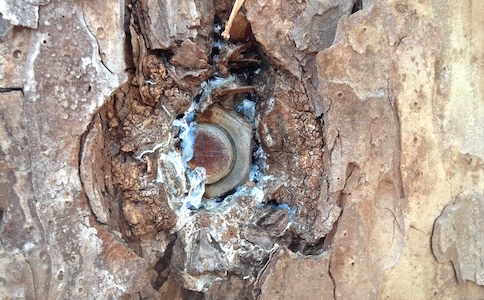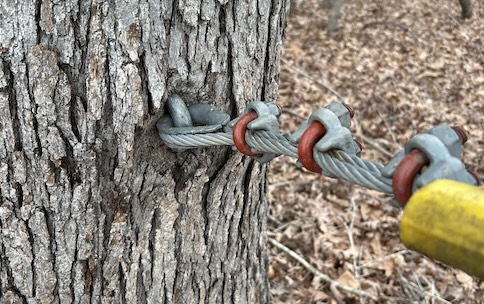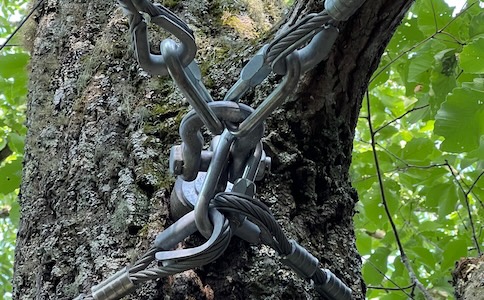Tree-Based Facility Maintenance: Managing Overgrowth
Tree-based zip lines, challenge courses, and aerial parks offer unique experiences—and equally unique maintenance challenges. One of the most common long-term issues is bolt overgrowth, where trees envelop the hardware used to support critical components. Tree-based facility maintenance should include early intervention to avoid costly repairs and operational interruptions.

Why Bolt Overgrowth Happens
Most tree-based facilities use nut-eye bolts (NEBs) to secure belay cables, guy wires, and zip line anchors. These bolts pass through the tree, distributing pressure with large, round dock washers. As trees grow in diameter, they slowly consume the washers and hardware—making bolts harder to inspect and eventually requiring full replacement.
While overgrowth isn’t an automatic failure under ACCT standards, mitigation becomes harder once washers are fully engulfed. Many facilities built 10–15 years ago are now seeing widespread bolt overgrowth during inspections.
The Hidden Cost of Replacing Overgrown Bolts
If bolt overgrowth is identified early, there are proactive measures that can help extend the life of existing hardware and maintain the original attachment point. But once tree growth has consumed too much of the bolt—especially when washers are fully engulfed or the threaded end is no longer accessible—the bolt must be abandoned. At that point, new hardware must be installed in an adjacent location.
Industry guidelines recommend the following spacing when relocating bolts:
- Vertical spacing: at least 6–12 inches from the original hardware, if staying in the same vertical plane
- Rotational spacing: at least 3 inches if the new bolt is offset more than 10 degrees around the trunk
In practice, these requirements can create real operational challenges. Trees often have limited usable space, especially in mature installations with multiple hardware penetrations. Even small changes in the placement of belay or rigging cables can lead to functional complications:
- A raised belay cable may become unreachable from the current platform
- Shifting an element’s rigging point may throw off alignment or introduce awkward loading angles
In some cases, platforms may need to be modified or entirely relocated to accommodate the new attachment points—resulting in increased costs, extended downtime, and changes to the element’s original design or user experience.
That’s why we emphasize proactive bolt overgrowth management as a core part of tree-based facility maintenance. When identified early, these issues can often be addressed with minimal disruption, helping preserve your investment and reduce long-term risk.

Our Proactive Solution to Bolt Overgrowth
At Challenge Towers, we’ve developed a cost-effective strategy to extend bolt life and preserve platform locations. This method includes:
- ✅ Removing the original bolt
- ✅ Adding new stacked washers to create growth space
- ✅ Installing a longer bolt in the same location
It’s a smart, repeatable approach when done early—every 3–7 years depending on tree type and growth rate.

The Value of Proactive Tree-Based Facility Maintenance
If caught too late, this solution won’t work. Late-stage overgrowth can force destructive intervention or create entry points for fungi and pests. The result? Rot, tree failure, and expensive course redesigns.
Tree-based facility maintenance requires timing and planning. Annual inspections by qualified professionals can identify early warning signs. Addressing them promptly helps you avoid future disruptions and maintain a safer, more reliable course.
Stay Ahead of Tree Growth
As the aerial adventure industry matures, proactive bolt overgrowth management must become standard practice. It reduces costs, protects your investment, and preserves the experience for every guest.
With the right strategy, you can extend the life of tree-mounted hardware while honoring the living systems that support your course.
Learn more about facility inspections and long-term maintenance strategies from Challenge Towers.
